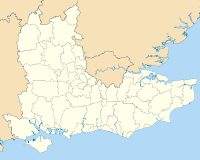Medway
- This article is about Medway in England. For others, see Medway (disambiguation)
| Borough of Medway | |
|---|---|

| |
| Geography | |
| Status: | Unitary, Borough |
| Region: | South East England |
| Ceremonial County: | Kent |
| Area: - Total |
Ranked 192nd 192.03 km² |
| Admin. HQ: | Strood |
| ONS code: | 00LC |
| Demographics | |
| Population: - Total (2002 est.) - Density |
Ranked 36th 250,921 1,307 / km² |
| Ethnicity: | 94.6% White 2.9% S.Asian |
| Politics | |
| Medway Council http://www.medway.gov.uk/ | |
| Leadership: | Leader & Cabinet |
| Executive: | Conservative |
| MPs: | Paul Clark, Robert Marshall-Andrews, Jonathan Shaw |
The Medway Towns, have developed into an area of urban sprawl situated near by an environmentally significant wetlands, reigon and are formed by the union of Chatham, Gillingham and Rochester in Kent, England. The towns, either side of the River Medway have made a wide and historically significant contribution to Kent.
History
The Medway area has a long and varied history dominated originally by the City of Rochester and later by the naval and military establishments principally in Chatham.
Rochester was established by the Romans, who called it Durobrivae (meaning ’stronghold by the bridge’) on an Iron Age site to control the point where Watling Street crossed the River Medway. The first cathedral was buillt by Bishop Justus in AD604 and was rebuilt under the Norman by Bishop Gundulf, who also built the castle which stands opposite the cathedral.
The Royal Navy opened a dockyard during the reign of Henry VIII; it was finally closed in 1984. It was protected by a series of forts including the Great Lines, Fort Amherst, Fort Pitt, Fort Borstal. Though Tudor in origin, the majority of buildings in the Historic Dockyard are Georgian. It was here that Britain's most famous wooden warship HMS Victory, Admiral Nelson's flagship, was built. Sir Francis Drake learned his seamanship on the Medway; Sir John Hawkins founded a hospital in Chatham for seamen, and Admiral Nelson began his Navy service at Chatham at the age of 12. His ship at Trafalgar, HMS Victory having been launched there in 1765. William Adams, the first Englishman to reach Japan, was born in Gillingham.
Succeeding centuries saw the erection of many fine buildings such as the Guildhall (now an exciting museum) in 1687, said to be one of the finest 17th century civic buildings in Kent, the Corn Exchange in 1698, originally the Butcher's Market, the small Tudor house of Watts Charity endowed by Sir Richard Watts to house 'six poor travelers' for one night each, Satis House and Old Hall, both visited by Queen Elizabeth I in 1573. In Medway there are 82 scheduled ancient monuments, 831.5 listed buildings and 22 conservation areas.
Among the important people owing connections with Medway are Charles Dickens, whose museum is located in Eastgate House in Rochester. William Adams, the first Englishman to reach Japan, was born in Gillingham.
Steps leading to the foundation of the Medway Unitary Authority
Throughout the 19th Century there had been proposals to link the Medway towns under a single authority. It was not until 1903, that moves began to take place. That date saw the creation of the Borough of Gillingham to which, in 1928, Rainham the adjacent parish was added. Gillingham remained separate even when, under the Local Government Act 1974, the City of Rochester, the Borough of Chatham and Strood Rural District Council were amalgamated to form Medway District Council. A further change in 1982 created the City of Rochester-upon-Medway. Finally, in 1988, Gillingham was at last amalgamated with the City and the whole became the Medway Council. Medway applied for city status for the competitions in 2000 and 2002, but lost. Rochester-upon-Medway itself had been a city, but had lost this status due to an oversight.
Demographics
Following the closure of HM Dockyard Chatham great attention was paid to the unemployment figures, by 1997 it stood at 5.5%, below the UK average. 50% of the working population works outside the district- which principally means London.
Places within the Medway Council area
External link

